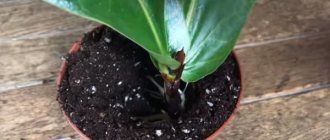Ficus trees are considered not too difficult to care for. If the plant is placed correctly and all growing recommendations are followed, it will quickly gain green mass. During the growing season, Benjamin and Ali regularly throw out new shoots. Rubber-bearing, Lyre-shaped stretch upward, giving a leaf every week. But sometimes the plant seems to freeze and stop increasing in size. There can be many reasons why a ficus does not grow - from poor care and the wrong pot to pest damage or simple aging.
Growth rate of ficus rubber and other varieties
Elastica ranks second in rubber content after Hevea, which is why the trunk is quite soft and lignifies late. In nature, it has a height of 30 m; if favorable conditions are created at home and the top is not removed, it can grow up to 10 m. Having reached the ceiling, the main shoot bends and takes a horizontal position. Of course, no one is going to let the Rubber Ficus develop in this way - it’s ugly and inconvenient.
Varieties that can grow as long as they are not limited by pruning include Black Prince. Every year it adds 60-100 cm, producing a new leaf every week during the growing season.
But there are cultivars of more modest sizes. For example, ficus Melanie will take a long time to grow up to a meter, since the distance between the nodes is only 2 cm. When planted several copies in one pot, it looks like a beautiful dense bush.
Other types worthy of attention:
- Lyre-shaped without pruning will grow up to 3 m, capable of adding 20 cm per year. But it is usually not kept in the form of a column - at the slightest deviation from the usual schedule, large, musical instrument-like leaves of the ficus grow larger or smaller than before. From Lirata, skillful flower growers create beautiful branched standard trees with raised side shoots that form a dense crown or bush, the width of which exceeds the height. Leaves that vary so much in size don't seem out of place.
- Ficus Microcarpa, obtained from seeds or by rooting a cutting, will grow like an ordinary tree, at an average speed (10-15 cm per year), eventually reaching 1.5 m. But no one is interested in it - Ginseng with special tricks, pruning the trunk , the roots are forced to stop growing and are made to look like a bonsai.
- The dwarf one fully lives up to its name - it is a creeping ficus that easily takes root with shoots. It does not stretch upward, but will grow in width. Capable of covering an area of 4 square meters in a few years. m. If he is given the opportunity.
- Binnendijka - looks like a tree with narrow long foliage, can be easily shaped, without pruning at home it will grow quickly, up to 1.5, maximum 2 m.
- The Bengal ficus in nature is a banyan tree - a tall tree that supports a wide crown with pillar roots. In pot culture, it is an attractive plant with a soft trunk that becomes woody over several years, capable of stretching very quickly, reaching 3 m.
When and how to change the pot for our Flower
The roots of seedlings at home grow quite quickly. In this regard, young specimens need to change their containers once a year. For trees older than 4 years, we change the pot once every 1-3 years, as the roots completely fill the container in which they live.
Recommendations for proper transplantation: • Choose a pot 2-3 centimeters larger than the previous one. If the container is too large, the flower will develop too slowly, all energy will be spent on developing a powerful root system. • We replant only in spring or summer. At other times, the bush either gains strength or comes to a dormant state. • Before transplanting, the seedling needs to be watered. • In a new pot, at the bottom we make drainage from small pebbles (as in the photo below), otherwise excess water will stagnate, sprinkle them with earth on top. • Carefully remove the tree from the old container so that the entire lump of soil is preserved. • It is necessary to slightly remove the top layer from the lump of soil, since the soil there has already been depleted. • We plant our lump in the prepared tub, sprinkle all the cavities with the prepared soil. • We compact the soil a little with our hands.
If the pot is more than 30 cm in diameter, you can refuse to replant; just remove the top layer of soil, as in the photo below, and add new soil containing 20% organic fertilizers.
Most often, the answer to the question of why growth slows down is that the pot is too large.
Why ficus benjamina and other species grow poorly
There may be one reason or caused by a whole complex of minor defects in care. To find out why the ficus stopped growing, you first need to rule out normal aging. The culture will live in the apartment for about 15 years, then it will first slow down and then stop developing, begin to turn yellow and shed its leaves. The branches will begin to dry out, starting with the smallest tree-like forms, and the rubber-bearing ones will simply wither away.
Of course, among all types of ficus there are long-livers. If from the moment of purchase they were provided with ideal care, cool wintering, regular transplants and constant high humidity.
The old specimen will still grow poorly, nothing can be done here. Unless you carry out drastic pruning and give a killer dose of stimulants. But when the ficus is beautiful, it is better not to do this - the decorative effect is lost for several years, and there is no guarantee whether it will be possible to restore the crown.
Other reasons for slowing or stopping growth:
- poor or improper feeding;
- insufficient and excessive watering;
- little or a lot of light;
- ficus will not grow normally in a pot that is too loose, or if the root has occupied almost the entire volume;
- a transplant has not been performed for a long time;
- low air humidity;
- damage by pests and diseases;
- temperature violation;
- frequent reshuffles.
Let's feed our ficus
Like any plant planted at home, ours also needs feeding. This is due to the fact that as the tree grows, it quickly takes all the nutrients from the soil.
Recommendations for fertilization: • Fertilize in spring and summer, once every two weeks. • Benjamin loves liquid fertilizers, both organic and mineral. • You can use wood ash or nettle infusions for better growth. • We fertilize only after preliminary watering, so as not to burn the roots. The video below shows the feeding process in more detail.
Ficus does not grow: what to do
If the ficus, in addition to slowing down its development, begins to shed its leaves, first of all you need to find out why this is happening. Then review the maintenance and care:
- Check for pests or diseases. If necessary, treat with appropriate medications. It will be possible to take any additional actions only when the plant recovers.
- Remove the ficus from the pot and inspect the earthen ball. This way it will immediately become clear whether the container is suitable and whether the owners have allowed it to overflow. He may need to be transplanted. If the problem is discovered in autumn or winter, it is recommended to wait until spring if possible. During the dormant period, only emergency transplantation is permissible when it comes to saving the plant.
- If necessary, watering should be adjusted. The ficus will grow normally when the top layer of soil dries out in potted specimens to the depth of the phalanx of the index finger, in a tub - by 3-4 cm. There must be lower holes for water drainage, a drainage layer occupying at least 1/5 of the container.
- It is recommended to review the feeding system. Universal fertilizers, and especially those intended for flowering crops, are not suitable for ficus - they contain little nitrogen and a lot of potassium. It may stop growing and the leaves will begin to fall just because of this. Folk remedies used on an ongoing basis (except for yeast) should generally be excluded without further consideration. The crop needs to be fed with a specialized mineral complex, in extreme cases - for decorative deciduous plants. There is a lot of nitrogen, the other components are balanced.
- You should carefully examine the plates to see if they have turned yellow due to a lack of microelements, which are better absorbed by spraying the aerial parts.
- Ficus needs diffused light. Elastica suffers the most from the bright sun; Lyre-shaped and variegated forms of other species can withstand some direct rays.
- At temperatures below 15° C, ficuses stop growing. Only Rubber and Bengal respond normally to heat of 27-30° C, the rest suffer.
- Air humidity should be constantly high. How to maintain it is up to the owners to decide. But wet expanded clay on a tray, sphagnum between the pot and the flowerpot, an indoor fountain, an air humidifier, and periodic bathing in the shower do not cancel, but only complement daily spraying. Especially in winter in a warm room.
Especially for those who like to move plants from place to place: ficus cannot stand this. Changes are stress, in response to which it stops growing even with ideal care. You need to rotate the pot relative to the light source no more than 20° at a time.
Does ficus grow in the shade? Ficus in the house - to wealth!
The ficus genus consists of more than 800 species, some of which are used as houseplants, although most are trees and shrubs. Ficus inhabits Asia, America and Africa (notice that everything starts with the letter “a”?). It is used as an ornamental plant, eaten and even as a religious symbol. The tree under which Buddha achieved enlightenment was a Ficus tree. In its original habitat, ficus is a landscape tree or shrub with a magnificent crown. In the room, ficus is good for its lush foliage. Ficus flowers are very small and are not of particular value.
Ficus varieties
I will describe only a few, those that may be in your apartment.
Ficus rubber plant Ficus elastica | Temperature: not lower than +18 degrees Do not keep on a cold floor or on a windowsill Lighting: warm and bright place, without direct sunlight Watering: moderate with warm settling water Air humidity: humid, it is necessary to wipe the leaves with a sponge Replanting: in spring, every 2 years Reproduction: cuttings |
Ficus benjamina Ficus benjamina | Temperature: not lower than +10 degrees Lighting: warm and bright place, without direct sunlight Watering: moderate with warm settling water Humidity: needs to be sprayed, especially in summer Transplantation: in the spring, when the roots come out of the pot Reproduction: cuttings |
Ficus lyrata | Temperature: not lower than +12 degrees Lighting: warm and bright place, without direct sunlight Watering: moderate with warm settling water, the soil should dry out before the next watering Air humidity: it is necessary to spray, wipe the leaves with a sponge Transplant: in spring Reproduction: cuttings |
How to speed up the growth of Ficus Benjamin
If the care is regulated, the place is chosen correctly, it has not been changed for a long time, and a healthy ficus does not grow and stands still, it needs to be stimulated artificially. Of course, in winter all processes are suspended, and you will have to wait until spring for new leaves or shoots to appear.
Transplants
To speed up growth, it is first recommended to transplant the ficus. It is better to carry it out when the beginnings of new leaves appear, at the very beginning of the growing season. The diameter of the pot should be 2-4 cm larger than before, even if the old ficus was too crowded. It is better to skip a season and wait for rapid growth in the next one than to lose a flower due to acidification of the soil.
It is recommended to change the substrate to another brand, not to make it yourself, and to refuse “improvements” with any components. It is also advisable not to use the universal one - there is nothing wrong with it, but the intended soil for ficus and palm trees is still better.
Sometimes gardeners shorten the roots of plants when replanting. For some crops and bonsai this is quite justified, but for ficus trees it is absolutely not suitable. They will stop growing for at least a season, and may even die.
Feeding
Accelerating growth processes with nitrogen alone is a mistake. There is a high probability that there will be a disproportion between the development of the above-ground part of the plant and the root, which needs phosphorus. This will not lead to anything good.
It is better not to increase the intensity of fertilizing, but to replace the cheap fertilizer for ficus with a good brand, and take only the liquid form. Crystals and powder, no matter what the manufacturers claim, do not completely dissolve; a sediment forms at the bottom, even if this is not visible to the naked eye.
When it remains at the bottom of the watering can, the plant does not receive enough fertilizer and is poured into the soil - the ficus receives shock from burning the roots. Even if this does not lead to the shedding of leaves, the flower will not grow for some time. And then he will receive a new portion of feeding.
It is better to give microelements in chelated form - this is the only way to ensure a sufficient supply of iron, manganese, zinc, copper, and molybdenum. They are not absorbed through the root, but settle in the soil or on the walls of the pot, forming a coating.
In winter, all feeding is stopped. During the rest period, they will bring nothing but harm. Unless the room temperature is high, but this is bad in itself, especially with low humidity.
Stimulants
At the beginning of the growing season, the ficus can be watered or treated with a stimulant. One, and not all that we managed to buy in the nearest store.
An excellent remedy is 1 tablespoon of vodka per glass of water. The plant gets a good shake-up, but this is exactly the case when stress is beneficial. Suitable for flowers that sit still for some unknown reason.
Expert opinion from the site Your Flower
Galina Alexandrovna
More than 30 years of experience in growing indoor and garden flowers
Ask a Question
If your ficus leaves are dull, it may be lacking oxygen. In addition to loosening the soil the next day after moistening, it is recommended to dissolve 2 tbsp in a liter of water. l. hydrogen peroxide, water and spray the plant.
When the reason is determined correctly, it will give results not the next day. There was an error - it won't get any worse.
Epin and zircon are excellent products. But it is recommended to use them not when the stress factor has occurred, but before it. For example:
- on the eve of pruning;
- on the eve of winter;
- a few days before the onset of cold weather or extreme heat;
- before going on vacation, when there is no confidence that the ficus will be provided with decent care.
Why did the ficus leaves stop growing? #63 Rosinka
Sent
Hello. At work, a colleague gave me a ficus because it had been in a pot for a year and was not growing. I have never dealt with ficus plants before. The plant is inclined to believe that it is robusta. The leaves are large and quite wide. The young shoot is reddish, the tips of the leaves turn slightly outward. The leaf itself is dark green, the reverse side is light. Now it consists of two adult leaves (they were rooted), one small leaf (6 cm long and 3 cm wide; no longer growing) and a young shoot 6 centimeters high. Problem: Not growing. The rooted cutting was planted a year ago, during which time only a small leaf grew. Conditions - North room. There are vertical blinds on the windows; I open them in the morning, but at about twelve o’clock someone will definitely close them tightly. I’m sitting near the window, and my colleague, who had it, is in the very corner. That is, there was very little light all year, now because so much. But in the same room the same ficus grows. Also grown from cuttings. Already 60-70 centimeters high. Cheerful friendly bush. — The pot, in my opinion, is too big. 16 centimeters in diameter. — We watered the ficus extremely rarely - when I tried to water it for the first time, all the water immediately drained into the pan. Then I watered it thoroughly with water a little warmer than room temperature.
How to help a plant
The ficus does not grow, but stands in one place - this worries all gardeners without exception. What should you do in such a situation? Once the cause has been determined, appropriate measures must be taken. If the cause was improper care, you need to do the following:
In order for a plant to grow well, it is necessary to provide it with the proper level of light. In spring it will be better to take it out to a closed balcony, but you should avoid direct sunlight. The reason for the wilting of the plant may be hidden in the burn. To alleviate the condition, you need to send it into the shadows.
Ficus benjamina is a big conservative; if its peace is disturbed, it does not grow. What should we do with it? There is no need to suddenly change the conditions for the flower so that it does not experience stress. If parasites appear, the plant should be sprayed with insecticides. If the cause is a fungus, then fungicides can be used.
For replanting, you should choose a pot that is much larger than the previous one. To renew a flower, it is worth removing rotten roots and changing the soil composition. Often, after performing these manipulations, the hostess manages to save her beloved handsome man from death.
Why leaves fall from ficus: cold, heat and dry air
Why doesn't Benjamin's ficus grow when it's cold in the apartment? This phenomenon can be explained by the thermophilic nature of the guest from the tropics. But flower growers often complain that the formation of new shoots and foliage is noticeably inhibited at a temperature that is comfortable for the crop, 17–23 °C.
Obviously in this case the plant:
- found itself in too dry air, which often happens when the heating is running;
- came into contact with cold air from an open transom, air conditioner or balcony.
Unable to tolerate being in too dry air, Benjamin's ficus sheds its leaves. What to do in this case? Move the pot to where the plant will be more comfortable, and if this is not possible, you can:
- use a household humidifier;
- irrigate the ficus crown daily from a distance of 20–30 cm;
- hold warm showers and wipe the foliage with a damp cloth.
Ficus rubber plant Ficus elastica
Rubber-bearing ficus, with good care, should produce 1 new leaf every 1 week from spring to autumn, while old leaves should not turn yellow or fall off.
Placement: All varieties of rubber ficus prefer a bright place, protected from direct sunlight. Variegated forms need a brighter and warmer place, but cannot withstand direct sunlight.
It is best to place the plant near a window curtained with tulle, except on the north side, in which case there is no need to curtain it.
In winter, ficus can be placed even in the depths of a bright, spacious, cool room, avoiding places near heating radiators.
Ficuses do not tolerate strong drafts, although they can stand near an open window or vent.
Temperature: preferably moderate, not lower than 18 °C. They like to “keep their feet warm” - you should not place a pot of ficus on a cold windowsill, marble or tiled floor, etc.
The soil temperature should be 22...24 °C. This thermal regime is very important for the rapid growth of both roots and above-ground parts. In a room with above-moderate temperatures, the leaves begin to droop down.
Watering: You should water very carefully with well-settled warm water, in winter - little by little.
For rapid growth, it is useful to warm up young ficus plants standing in the room once a week by pouring water heated to 45 ° C into a tray. In winter, ficus plants are watered with water at room temperature.
In a room with steam heating at 22...24 ° C, water every day. The ficus soil ball should not dry out, but it should not be too damp.
Air humidity: Leaves must be regularly wiped with a damp sponge on both sides. Ficus loves spraying, but only with warm and preferably boiled water (otherwise there will be a white limescale coating on the leaves).
Feeding: Ficus is a fast-growing plant that requires a lot of nutrients. Fertilizer watering is used only for healthy, growing ficus plants that are well rooted. They are produced in the evening after watering.
A weak solution of a mixture of mineral salts has a good effect on the development of ficus: ammonium nitrate - 0.2 g, potassium salt - 0.1 g, superphosphate - 0.3 g, dissolved in 1 liter of water. Ficus is watered with this solution from March to October 1-2 times a month. You can use a solution of mullein or bird droppings.
You can use a complex fertilizer for deciduous plants.
Transplantation: Carry out in the spring, when the roots have entwined the entire earthen ball, young plants after a year or two, adult plants are recommended to be replanted or transplanted after 2-3 years. For untransplanted ficuses, it is useful to change the top layer (2-3 cm) of soil in the spring.
Ficus should not be transplanted into very spacious pots or tubs. An increase in the container is allowed by 3-4 cm in diameter and 5-6 cm in height larger than the size in which the transplanted plant was located.
The material of the pot - ceramic or plastic - does not matter. The presence of a drainage hole is mandatory; a layer of drainage of 3-4 cm should be poured down.
Ficus, as a rule, endures transplantation very painfully; to relieve stress, you can spray it with Epin.
Growing problems
New leaves become smaller, old ones turn yellow and fall off - the plant does not have enough nutrients, it needs to be replanted in nutritious soil.
Yellow spots appear on the leaves or the edges of the leaves turn yellow , the leaves fall off prematurely - if there is excessive watering, watering should be moderate, i.e. the soil should have time to dry out.
Sudden falling of leaves - waterlogging of the soil; This phenomenon can also be caused by watering with cold water, low room temperature, lack of light, excess nutrients in the soil or a cold draft. Spraying with Epin solution gives good results.
Falling of the lower leaves - It is believed that the falling of the lower leaves in tree-like forms of ficus is a natural phenomenon, but this is not entirely true, the lower leaves, naturally, periodically fall off as they age, but the trunk should not become completely bare. Bareness of the trunk occurs due to untimely replanting, replanting in poor soil, lack of fertilizing, violation of temperature and light conditions.
Brown spots on the tips and edges of leaves - When the room temperature is too high, the air is dry, or when overfeeding with fertilizers.
If you have just bought a ficus, you should replant it immediately or simply change all the soil. This land is only suitable for transportation.
In this case, the plant will most likely shed some of its leaves - this is a natural reaction to transportation, replanting, etc.
In this case, the plant should be sprayed with epin and left alone for a while - do not move or fertilize.
The decorative appearance of the plant will gradually be restored. If you have flooded the ficus: Take the plant out of the pot, shake the old soil if possible, inspect the roots, if there are rotten ones, cut them back to the living ones, sprinkle the cuts with crushed charcoal or activated carbon, down, pour enough earth onto the drainage so that the surface of the earth remains at the same level , i.e.
There is almost no need to add soil from above, only from below and on the sides (you need to add soil from above, only if you managed to shake off the old top layer of soil). The first days after transplantation, greatly reduce watering of the ficus. If this does not help, you should try cutting off the top and rooting in water with a rooting agent. Attention - White milky sap is poisonous!
Reproduction:
Propagated by cuttings, a piece of stem or a leaf with a bud.
The rubber-bearing ficus gives roots very slowly precisely because of the milky sap it contains.
It is usually recommended that immediately before placing a branch in water for rooting, do the following: rinse the cut area under a small stream of water - just gently remove the frozen juice with your hands, and then immediately place the cutting in the water.
You can do this - in a greenhouse made of a transparent plastic box about 20 x 10 with a gap for air access. Pour wet expanded clay onto the bottom of the greenhouse for moisture, root the shoot in a small pot in the ground, not in water, place the entire greenhouse on a radiator for bottom heating, which accelerates the formation of roots.
When propagating by leaf, the mature cut shoot is cut into segments with one leaf. The leaf is carefully rolled into a tube, tied and planted in the sand; a peg is passed through the tube of the rolled sheet and stuck into the sand.
Before planting, the lower cut of the cutting is split and a grain of sand, a pebble, a piece of wood chips, oat grain, etc. is inserted into the split so that the split does not close. Before planting, the lower cut can be dipped in root.
Or - soak the cutting in water for a day (so that the tissues are saturated with water), then in a root formation stimulator (heteroauxin), according to the attached instructions, then plant it in moist soil under a cap, spraying from time to time.
When a new leaf appears, the cap can be removed. It is better to take cuttings for leaf propagation in May-June. It takes a long time for such a cutting to take root.
Rooted cuttings, depending on size, are planted in a pot with a diameter of 7-9 cm in a mixture of turf, peat, leaf soil (1:1:1) with the addition of a small amount of sand, horn shavings or blood meal. As the ficus grows and weaves into a coma, it is transferred to a larger pot using the same soil composition. Caring for young plants is normal.
Remember that variegated forms need higher temperatures, and when cuttings they take root much worse compared to monochromatic ones.
Ficus benjamina leaves fall due to lack and excess of light
In order for the plant to feel “at home”, to actively produce shoots, and for the ficus Benjamin to not fall leaves, it needs a long daylight hours, and the lighting should be bright, but diffused.
Compared to other related species, the foliage of Ficus Benjamin is thinner and smaller. This means that the scorching rays of the sun can be possible causes of the plant’s painful condition. Leading to evaporation of moisture, dehydration of leaves, and sometimes serious burns, excess sun negatively affects the strength and growth of ficus.
Deprived of moisture reserves, the leaf plates turn yellow prematurely and then crumble.
Exposing shoots not only worsens the appearance of plants, but also weakens it. The fewer leaves on the crown, the slower the photosynthesis, and the ficus does not receive the energy necessary for growth.
Unfortunately, a similar picture can be observed if the ficus is experiencing a lack of sun. Young shoots become thinner and stretch out. Fresh foliage becomes smaller, and those located on the lower tiers dry out. As a result, leaves fall from the Benjamin ficus. The plant loses its decorative effect, its strength is depleted, and without proper care it may die.
This is why ficus benjamina does not grow if the place for it is chosen incorrectly. It's quite easy to fix the situation. The main thing is to do this immediately, at the first sign of ill health of your green pet.
If you follow the other rules of care, you should find a place protected from the midday sun where the flower will be illuminated from 10 to 14 hours a day, and the ficus will come to life. From autumn to the end of March in the middle zone, it is useful for the plant to provide additional lighting. The same measure will help maintain the beauty of a tree standing away from the window.
Having taken all measures to improve the situation, it will, of course, not be possible to return the ficus to its former appearance. But the growth of full-fledged foliage will resume on new, young stems.
What to do if ficus benjamina drops leaves despite proper lighting? No less often, the plant suffers for other reasons. These include:
- moisture deficiency or, conversely, regular waterlogging of the soil;
- drafts;
- excessive dryness of indoor air;
- non-compliance with temperature conditions.
Even a sudden change of environment can affect the well-being of a plant. For example, moving from a store to a home becomes a shock for a ficus if the purchase is made during the cold season.
Caring for rubber ficus - propagation and how to form, prune
Where the rubber ficus grows, people get sick less often, and if this happens, the person suffers a milder form of the disease, since his immune system copes with the pathology faster. The air in the room is cleared of many dangerous compounds. But it is contraindicated for asthmatics to keep this plant in the house, as attacks of suffocation become more frequent.
The tree produces elements that have a beneficial effect on the emotional background and relieves nervous tension.
Ficus brings good luck in all its manifestations: standing in the bedroom next to the bed, it helps to conceive a child, and in the kitchen it ensures plenty of food. The higher he grows, the better his influence and the “stronger” he becomes.
How to care
This type of ficus has more beneficial qualities than negative ones, but it is worth purchasing it on the condition that the owner can provide proper care. Otherwise, the plant will quickly shed its leaves, stop developing and eventually die.
The most common varieties differ in color, size and attitude to care. Ficus melanie rubbery has dark green leaves up to 20 cm, a bushy crown and is one of the most unpretentious and tenacious. In contrast to him is the Tineka, a capricious, variegated beauty, which at the slightest non-compliance with the regime becomes covered with brown spots.
Important : milky sap is harmful to pets and people. When it gets on the skin, it provokes irritation, and an animal that bites through a leaf or eats it can become poisoned and even die.
Ficus elastic requires an individual approach, but is not capricious. The undemanding long-liver will appeal to novice breeders and experienced florists. The main thing is to choose the right place for the pot and not to overdo it with care.
Lighting
Rubber-bearing varieties of ficus have large leaves and a low concentration of chlorophyll in them, therefore they are demanding on lighting. Bright, but not directional, but diffused sunlight will be the ideal source of vitality for this type of plant.
In partial shade, growth slows down, but this is not critical for the ficus itself. If all the windows face north or you can see dense tree crowns behind them, you will have to worry about purchasing sources of artificial lighting for the plant.
Important : staying in the shade for a long time can cause the lower leaves to dry out and fall off.
Watering
The soil should be carefully moistened with settled water at room temperature after the top layer of soil has dried by 2 fingers. This can be easily checked using a regular toothpick or other wooden stick.
It is important to provide a moderate amount of liquid, the amount of which depends on the pot. The top layer should be wet by 0.5 fingers.
Humidity level
For the healthy functioning of house plants, the humidity in the room should be at least 40% in the cold season and up to 60% in the hot summer. If these conditions are not met, in the case of ficus, you will need to spray the leaves with a sprayer or wipe them with a damp cloth, which will not damage the plant tissue.
Optimal temperature
Ficus is heat-loving and can easily tolerate heat indoors, but only with sufficient air humidity. In summer, a temperature of 25-28°C above zero is suitable. In winter, when there is a lack of light, the temperature drops to +16-18°C with minimal watering.
Important : drafts lead to the death of the plant, which will quickly shed its leaves. To avoid this, it should be removed from the room during ventilation.
soil mixture
The rubber-bearing ficus prefers a porous and fertile substrate: you need to add turf soil, a little leaf humus and sand to the universal peat mixture for houseplants.
Fertilizers
Due to their dislike for frequent replanting, large specimens require significant feeding. In spring and summer, during the period of active growth, nitrogen-containing fertilizers are required to increase green mass and flowering. Organic or mineral are suitable.
The former include various types of manure, and the latter include urea, nitrogen and urea compounds. Dosing organics is difficult at home and you can easily “burn” the rhizome, but with mineral products you just need to study the instructions on the package.
Experienced gardeners recommend fertilizing once every 2 weeks during the active and growing season (February-September). To enhance the effect, you can spray the leaves with Emerald, after making a weak solution. Winter feeding is dangerous for the plant.
How to control pests
Most often, rubber ficus is affected by the following insects:
- Thrips - a shiny coating appears on the greens, and red spots below.
- Spider mites - a problem for many houseplants - look the same for everyone: gray-white dust, cobwebs and rapid wilting. Damaged leaves become transparent.
- Scale insect - the plant is covered with a sticky coating.
- Mealybug - roughness is felt on the inside.
The scheme for dealing with them is practically no different:
- Rinse the tree with running water.
- Treat with an insecticide or any traditional method against insect pests, such as a solution of laundry soap.
- Quarantine under a bag for a day and repeat the procedure after 7-8 days.
- Remove from other plants for a week.
- Treat the place of previous stay with the same product.
- Carry out preventive measures for neighboring flowers.
- If after a week of “loneliness” symptoms appear again, repeat the procedure.
The main thing is to notice the pest at the initial stage, and not when half the tree is affected. Otherwise, the chances of saving the plant are reduced.
How to shape the crown of rubber ficus
Pruning is performed from mid-February to April. It is necessary so that a beautiful crown with branches is formed, and not a clean trunk remains.
Remove up to 6 internodes from all tips. This should be done wearing thick rubber gloves with a sharp, disinfected knife. The leaking juice is wiped off with a damp sponge, but the sections are not treated with anything additional. The rubber becomes hard in the air and will clog the wound itself.
You can also form a lush crown using a sewing needle. The trunk is pierced to ⅓ thickness. If there are several holes, the branch will grow from the lowest point. For this reason, stimulation should be done at the top and then at the bottom.
Ficus propagation
Plants of this type reproduce in two ways:
- Air layering. A vertical cut of 0.5 cm is made on the stem under one of the leaves. A match, previously powdered with root-forming powder, is stuck into it. A bunch of sphagnum moss is attached on top using threads and covered with a film to create a greenhouse effect. After a few months, roots will appear in this place, the liner is cut off with a small margin and planted in a separate pot.
- Cuttings. A beautiful, strong cutting with healthy leaves separates. Place in a glass of warm water until the juice stops flowing. Then it remains in a new container with the roots for a period of 2 weeks to a month to form a strong, viable system and is planted in a pot with drainage and the correct soil mixture.
The plant should be propagated after cold weather, but before the start of the growing season.
Transfer
Only young individuals need to replace the soil and pot annually, as they need larger and more stable containers in order to withstand the weight of the massive crown. It is better to move in the spring or early summer.
Basically, ficus is replanted as needed, that is, when the rhizome has taken up all the free space or some kind of trouble has occurred.
: the plant likes to find itself in a new home and it immediately begins to fill the free space with roots, conquering the territory.
When replanting an adult specimen, you need to clean the entire root from the old soil, rinse it and carefully place it in the prepared substrate. It is better to place a young plant in a larger pot together with an old lump of soil, so that it takes root more easily.x
Plant diseases
Almost all illnesses in house flowers appear due to improper care. As preventive measures, experts recommend individual care of the plant, taking into account its variety and development characteristics.
The leaves are curling
There are several diseases that can provoke such a symptom:
- Infestation with sooty fungus. The causative agent is a pest, living on the leaves of which is manifested by a sticky coating, and in advanced cases - by curling of the plates. It is enough to rub a sponge with laundry soap and thoroughly treat the entire plant, but without causing mechanical damage.
- Cercospora blight. Also a fungal infection that occurs due to waterlogging. The main symptom is black spots, but later the leaves curl and die. The affected areas are removed, watering is reduced to a minimum, and the tree itself is sprayed with an antifungal agent until the symptoms disappear.
- Anthracnose. Rusty spots are at the initial stage of the disease, but it is better not to let the leaves curl and fall off - the plant cannot be saved. The problem is solved by treating with a fungicide.
- Botrytis. The spots resemble anthracnose, but have a brown edge. Treatment is with antifungal drugs.
Other factors that can cause ficus leaves to curl:
- Sunburn - directed rays cause rubber plants to react to them, but the plates will not burn, but will return to their original form, returning to normal.
- Low air temperature - a draft or sudden cold will cause the leaves to curl. If you do not react in time, the root system will die.
- Fertilizer deficiency - lack of nitrogen affects the shape of the plates, causing them to curl. Fertilizing will solve the problem.
The leaves are falling
The loss of these crown elements is not normal for the plant. Only the lower ones are shed during natural aging, which does not occur soon.
Therefore, this phenomenon refers to the symptoms of an illness caused by poor conditions: overwatering, cold, lack of light, excess nitrogen, sudden significant jumps in air temperature, changes in usual maintenance standards, sunburn.
More often, pest-affected leaves fall off and die after being eaten.
Leaves are drying
The plates begin to take on the appearance of brown crumpled paper mainly at the edges. There are varieties of ficus that have a very specific color, which can be perceived as drying out, but lighter colors are just a difference in pigmentation.
In autumn, yellowed leaves are a seasonal phenomenon, but this also happens for the following reasons: draft, poor lighting in the room, hot, low humidity (ideal environment for spider mites). After placing the plant in the necessary conditions, treat the leaves with Actellik or Fitoverm.
Insufficient and excessive moisture can also cause such symptoms, but if in the first case it is enough to water more, in the other you will have to replant the plant and check the rhizome for rotting.
Important : if only the tips of the leaves dry, it means the room is hot or the soil is too dry.
As a rule, ficus in this state stops growing and throwing out new branches.
Slow leaf growth
Poor development is the main symptom of poor tree health. This can be influenced by a lot of factors, one of which is a lack of fertilizer, but much more dangerous is parasites, fungus or another disease.
The plant may stop growing for a while, simply experiencing the shock of a change of location. For example, after a purchase, finding yourself in new conditions, you need time to adapt; during this period, development slows down.
If there are no new branches on the ficus for a long time, the wounds do not heal well, the leaves do not develop, and their color has become dull, the matter is definitely a disease. An accurate diagnosis can be made by careful examination of the lower parts of the foliage and rhizomes.
White plaque
Powdery mildew is a disease in which the leaves seem to be dusted with flour. At the initial stage, plaque is easily removed with a sponge soaked in a solution of laundry soap (does not wash off). It is recommended to remove severely affected areas. If the condition of the plant leaves much to be desired, you cannot do without spraying with fungicidal preparations.
Before you begin to take any measures regarding a new plant, you should find out its variety and the characteristics of caring for this species. Rubber-bearing ficus requires care that differs from that used for variegated ones. Only in this way will it be possible to provide proper care and grow an evergreen tree at home that brings good luck.
Source: https://podomu.info/comfort/plants/leaf/tree/fikus-kaucukonosnyj.html
Moving the pot from place to place
Why doesn't my house ficus grow?
Of course, if a flower suddenly stops growing, many gardeners begin to move it around the room in search of a much more suitable place. But such an approach will not bring anything good. The thing is that it is recommended to choose the optimal location for a home ficus in advance. If you subsequently start moving it and rearranging it, the plant may also lose its leaves. Therefore, the first thing you need to do to grow Ficus Benjamin or the Rubber variety is to determine the ideal location. Take care of your plant: provide proper care for it, and you will not need to deal with illnesses, stunting or loss of leaves.
Ficus grows in length, not width, what to do. How to make a ficus grow wider and not higher
Good afternoon Several years ago I planted a ficus leaf and now it has grown to a height of more than 1 meter.
It looks like 1 trunk and leaves on it. Moreover, it definitely needs support, otherwise it will fall.
Tell me, is it possible to stop the upward growth and direct the growth wider, maybe cut off the top? Thank you!
Tags: ficus
Answer #1
You didn’t indicate what kind of ficus you have??? If the ficus is Benjamin, then yes, your ficus should have been “trimmed” back in childhood. Now you need to cut off the top by 10-15 cm (no more and sprinkle the cut with crushed activated carbon. Place the top in some water and grow a new tree, but trim the top in time. It is enough to wait for four or five young leaves and pluck out the top. Next will come the lateral shoots - the same with them - 4-5 leaves and pinch off the tops. Your tree will be curly.
Diseases of rubber ficus
We recommend reading our other articles
- The best varieties of Nectarine
- Growing tomatoes in a greenhouse
- Grape variety Delight
- Best Egg Breeds of Chickens
Protecting ficus from diseases and pests
Diseases that can harm this ficus include sooty fungus, botrytis, root rot, anthracnose, and cercospora. However, it must be borne in mind that this plant has a good immune system, so problems due to disease are extremely rare. If the plant still gets sick, you can use drugs such as Trichodermin, Fitosporin for spraying, or simply spray the plant with a weak solution of potassium permanganate.
Pests that often besiege rubber ficus: nematodes, mealybugs, scale insects, spider mites, aphids. Fight against scale insects and spider mites by washing the leaves with soapy water or infusion of tobacco dust (4 tablespoons per liter of water). Insecticides for indoor flowers will help against other pests, for example: “Aktellik”, “Fitoverm”, “Gaupsin” and the like.











